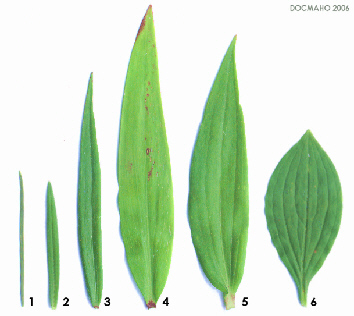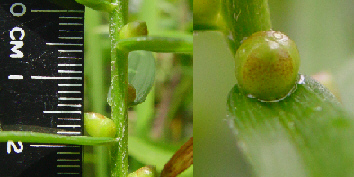|

HOME






LILIUM-
BASICS

BULB-SOURCES
/
ZWIEBEL-QUELLEN

LINKS
&
LITERATURE


EMAIL


NOURISH
THE
CHILDREN

POWERED
BY
my-new-skin.com
| |

|

|
 THE
LILY STEM THE
LILY STEM
 DER
LILIENSTÄNGEL DER
LILIENSTÄNGEL
|

|
 GENERAL STRUCTURE
GENERAL STRUCTURE
Lilies
belong to the family of monocotyls (plants germinating with one seed
leaf). The stems, in most species, are
upright and strong; height varies from some centimeters up to 2 and more
meters.
No
secondary growth of the stem does appear as well as no branching. The
leaves are more or less lanceolate (with variations) with parallel veins
(see below).

|
|
 PRINZIPIELLER BAU
PRINZIPIELLER BAU
Lilien
gehören zur Familie der Monokotylen (Einkeimblättrige). Bei den
meisten Arten sind die Stängel aufrecht und stark; die Höhe variiert von
wenigen cm bis 2 m und mehr. Es
gibt kein sekundäres Dickenwachstum der Stängel sowie keine
Verzweigungen. Die Blätter sind +/- lanzettlich (mit Variationen) mit Parallelnerven (siehe
weiter unten). 
|
|
GERMINATION Two
main forms of germination occur: epigeal (above soil level) and
hypogeal (below soil level), whereby immediate (after falling
off the mature capsule) as well as
delayed is possible. The cotyledon (seed leaf) is only visible
in case of epigeal germination, is strap-like and starts to wilt as soon as the
first true leaf appears which is +/- lanceolate (please click on pics for large
versions!).
|
|
KEIMUNG
Im Prinzip gibt es zwei Keimungsformen:
epigäisch (oberirdisch) und hypogäisch (unterirdisch), wobei die
Keimung sowohl sofort (nach der Kapselreife) als auch verzögert stattfinden
kann . Das Keimblatt, das man nur bei der epigäischen Form sieht,
ist bandförmig und welkt sobald das erste lanzettliche Laubblatt
erscheint (bitte auf die Bilder für große Versionen klicken!).
|


|
LEAF SHAPES As
mentioned above, the principle leaf shape in lilies is lanceolate with parallel
veins: |
|
BLATTFORMEN
Wie oben erwähnt ist die
prinzipielle Blattform lanzettlich mit parallelen Nerven:
|
|

|
"Lanceolate"
is a very elastic term - on the one hand, a "narrow lanceolate" leaf
can be virtually linear, on the other hand a "broad lanceolate" leaf
looks nearly "oval". However, all leaf shapes have in common that they
are acuminate. The following
image shows scans of several leaves from linear to broad-lanceolate - it can be
seen clearly that all of the leaves are acute (please click on pic for large
version!). Most lily species have
leaves without leaf stalks, however, some trumpets and orientals (and their
hybrids) sometimes have short leaf stalks (stalk = petiol) which can be seen in leaf no. 5. 
|
|
"Lanzettlich" ist ein
dehnbarer Begriff - einerseits kann ein "schmal-lanzettliches"
Blatt linear sein, andererseits mag ein "breit-lanzettliches"
Blatt fast oval aussehen. Jedenfalls sind alle Formen zugespitzt.
Das folgende Bild zeigt einige
unterschiedliche Blattformen von linear bis breit-lanzettlich - deutlich
ist jedenfalls die besagte Blattspitze zu sehen (bitte auf das Bild für
große Version klicken!). Die meisten Arten haben sitzende Blätter, bei
Trompeten- und orientalischen Arten (und Hybriden) kommen aber auch kurz
gestielte vor (Stiel = Petiolum), wie bei Nr. 5 ersichtlich.

|
|

<click
the pic above>
Different
lily leaf shapes / Unterschiedliche Lilienblattformen
1:
L. pumilum; 2: L.
bulbiferum; 3: Trumpet-hybrid; 4: L. henryi;
5: Oriental-hybrid; 6: L. martagon.
|
|
|

|
|
|
LEAF ARRANGEMENTS Two
main kinds of leaf arrangements can be found: scattered and whorled - see images
below (please click on pics for
large versions!). Some species, like
L. martagon, have both forms, namely one or
two whorls and above, between the upper whorl and the inflorescence, some
smaller leaves scattered. 
|
|
BLATTSTELLUNGEN Es
kommen zwei Arten von Blattstellungen vor: verteilt und in Blattquirlen -
siehe folgende Bilder (bitte
auf die Bilder für grosse Versionen klicken!). Einige Arten, wie L.
martagon, besitzen beide, nämlich 1 oder 2 Quirle und zwischen
obersten Quirl und dem Blütenstand einige kleinere Blätter
verteilt.

|
|

<click
the pic above>
Scattered
leaf arramengement /
Blätter verteilt

|
|

<click
the pic above>
Whorled
leaf arrangement / Blätter in Quirlen |
|
LEAF BULBILS Several
species (and also often their hybrids) form bulbils, small daughter bulbs, in the axils of the upper
leaves. They fall off during the later course of the year and, therefore,
provide a clonal propagation of the mother plant. The image belows shows this
feature in the most typical species, L. bulbiferum
("bulbiferum" means "bearing bulbils"; please click on pic
for large version!). 
|
|
BLATTBULBILLEN Einigen
Arten (und oft auch deren Hybriden) bilden Bulbillen, kleine
Tochterzwiebeln, in den Blattachseln.
Diese fallen im späteren Verlauf der Vegetationsperiode ab und sorgen so
für eine klonale Ausbreitung der Mutterpflanze. Das folgende Bild zeigt
dieses Phänomen bei der wohl typischsten Art L.
bulbiferum ("bulbiferum" bedeutet " "Bulbillen
tragend"; bitte auf das Bild für große Version klicken!).

|
|

<click
the pic above>
Bulbils
in leaf axils of L. bulbiferum /
Bulbillen in blattachseln von L. bulbiferum |

BACK
TO
ZURÜCK ZU "BASICS"
|
![]() T
h e G e n u s L i l i u m
T
h e G e n u s L i l i u m
![]()